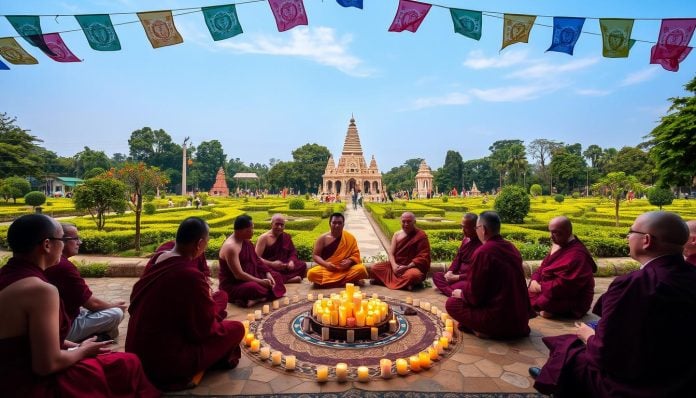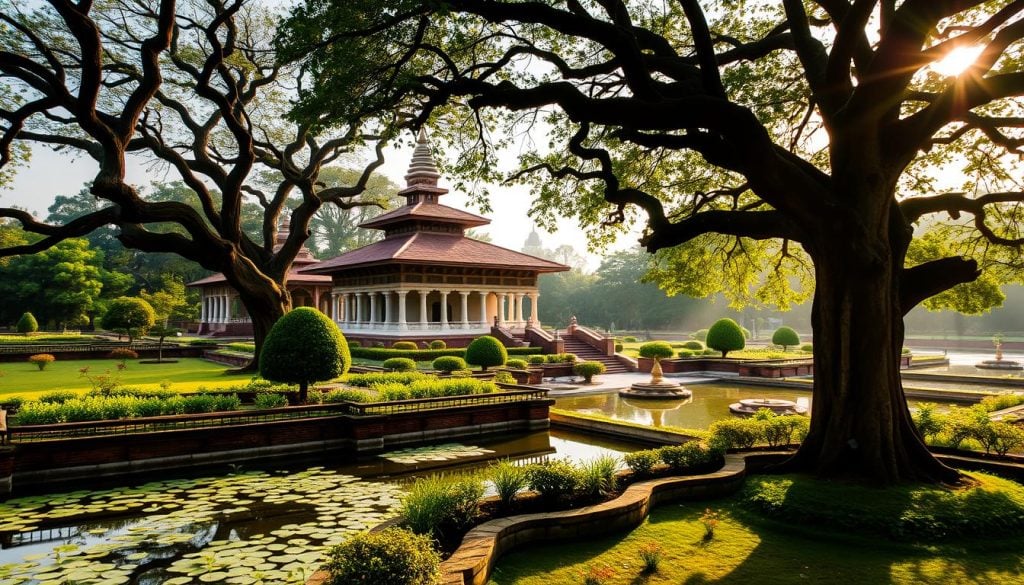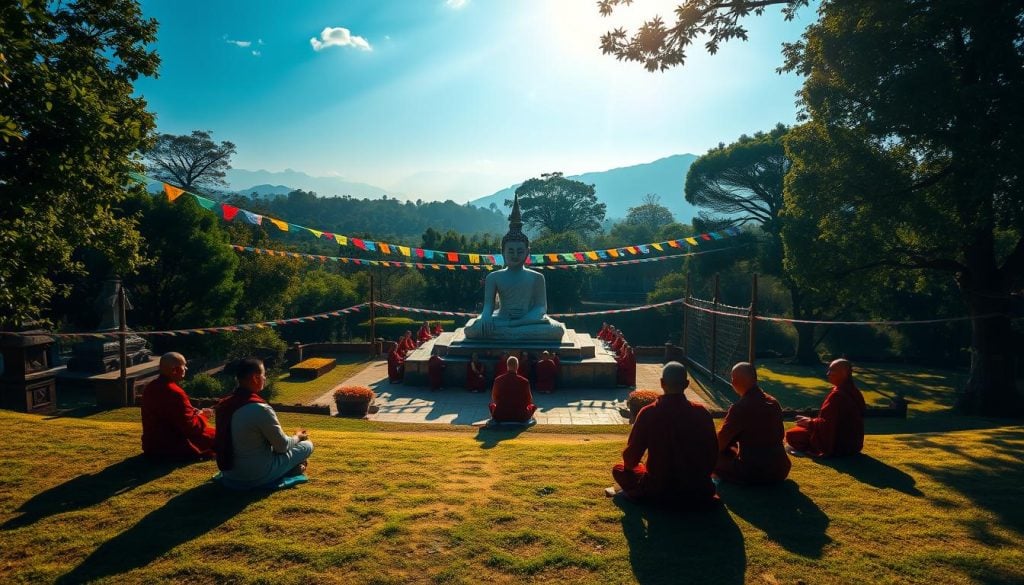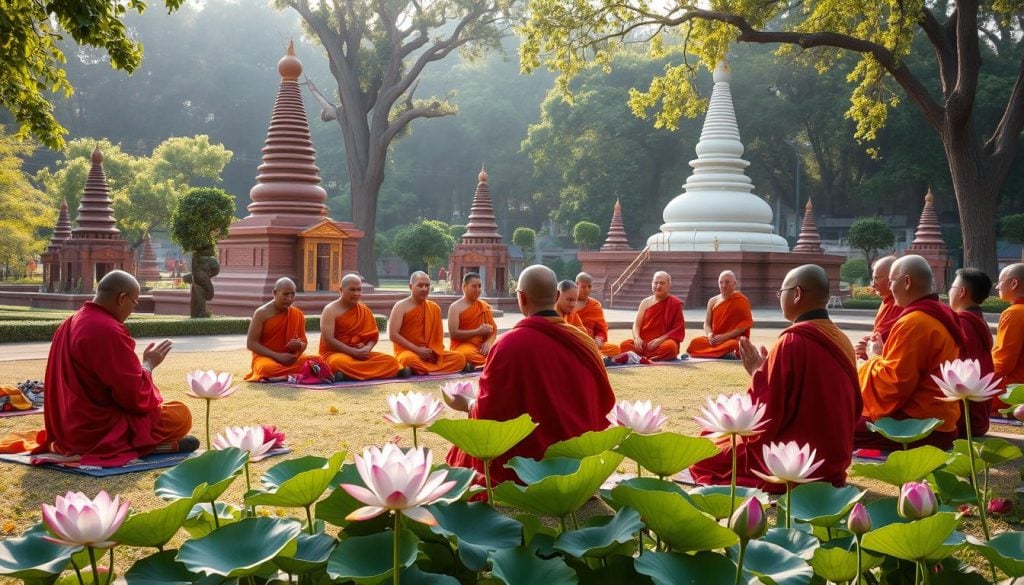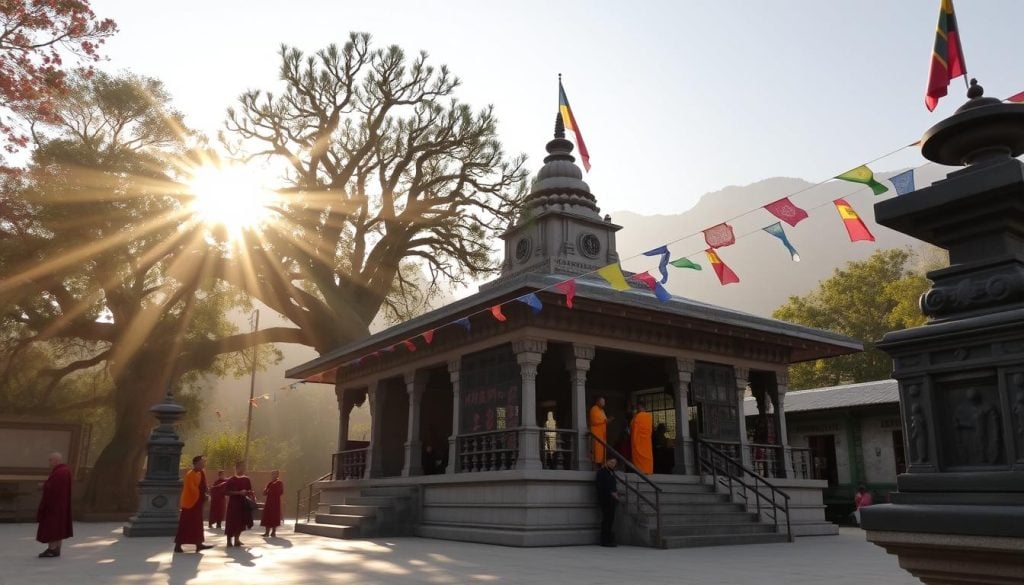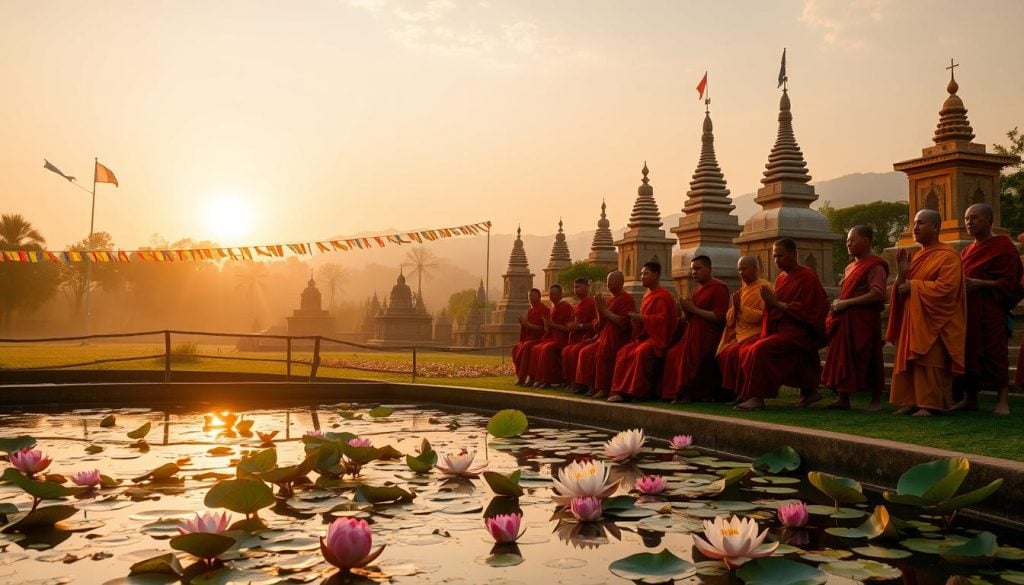Have you ever wondered why Buddhist chanting and prayer ceremonies in Lumbini resonate deeply with those who experience them? Lumbini, in the heart of Nepal, is not just the Buddha’s birthplace. It’s a sacred realm where spiritual practices create a deep connection among all.
The serene chanting and prayer events here are a way for people to reflect, meditate, and show devotion together. As you dive into the UNESCO World Heritage site’s vibrant atmosphere, you’ll see the importance of sacred Buddhist rituals. These rituals echo through time and space, inviting you to explore the faith that brings people together from all over the world.
Lumbini: The Birthplace of the Buddha
Lumbini is a place of great historical importance. It is where the Buddha, Siddhartha Gautama, was born in 623 B.C. Located in Nepal, it draws many pilgrims and visitors from all over. It’s a UNESCO World Heritage site, known for its rich cultural heritage.
The Maya Devi Temple is at the heart of Lumbini. It marks the spot where Queen Maya Devi gave birth to the Buddha. The temple is adorned with carvings and ancient relics, showing its deep spiritual history.
There’s also an inscription from Ashoka’s pillar from 249 B.C. It highlights Lumbini’s role as a pilgrimage site. The pillar shows the site’s importance in early Buddhist history and the devotion it has inspired over the years.
Archaeological digs in Lumbini have uncovered important early Buddhist remains. These include parts of stupas and monasteries. They give us a glimpse into the early practices and beliefs of Buddhism. Exploring this sacred place, you can reflect on its key role in Buddhist traditions.
Understanding Buddhist Chanting
Buddhist chanting is a key part of spiritual practices. It involves reciting mantras and sutras that share the Buddha’s teachings. This practice is more than just speaking words. It connects you deeply with mindfulness, faith, and respect.
There are many styles of Buddhist chanting, each with its own tradition and region. Each style adds something special to the experience. It helps you enter a meditative state and think deeply about yourself. Chanting connects your mind and spirit, making you feel in tune with Buddhism’s teachings.
- Buddhist prayers often go hand in hand with chanting, deepening your spiritual path.
- Common chants include the Heart Sutra and Metta Sutta, each filled with deep meaning.
- Joining in group chanting builds community and spiritual growth together.
People who chant often feel more peaceful and calm inside. By joining in, you connect with Buddhism’s teachings. This can lead to deeper understanding and personal change.
| Chanting Style | Key Features | Spiritual Benefits |
|---|---|---|
| Tibetan Chanting | Uses deep tones, often with instruments | Boosts focus and spiritual energy |
| Thai Chanting | Features melodic rhythms and tonal changes | Helps with relaxation and emotional release |
| Shingon Chanting | Repeats mantras with vivid images | Creates deep meditative states |
Starting with Buddhist chanting can lead to deeper spiritual insights. It helps you connect with the teachings that guide your journey. With practice, the Buddha’s wisdom can become a part of your life.
Buddhist Chanting and Prayer Ceremonies in Lumbini
Buddhist chanting and prayer ceremonies in Lumbini are very important. They bring people together, creating a sense of community and spirituality. These events happen near the famous Maya Devi Temple, attracting locals and visitors from around the world.
Monks lead these ceremonies with beautiful chanting. They share teachings and blessings through their songs. These ceremonies help people find peace and connect with their spirituality.
Everyone plays a role in these ceremonies. The community’s involvement creates a special atmosphere of devotion and unity.
- Fostering Community Bonds: These ceremonies help strengthen friendships and connections.
- Spiritual Nourishment: Collective prayer rejuvenates the spirit and boosts community morale.
- Cultural Heritage: These ceremonies help keep Lumbini’s rich heritage alive.
Whether you’re a Buddhist or just curious, joining these ceremonies in Lumbini is a unique experience. It lets you dive into the spiritual heart of this sacred place.
Importance of Ceremonies in Buddhism
Ceremonies in Buddhism are more than just traditions. They are key moments that connect us to our spiritual roots. Each ceremony is a step towards coming together in worship, creating a strong bond in the Buddhist community.
These gatherings help pass on the Buddha’s teachings from one generation to the next. They keep our understanding of faith alive in our daily lives. By joining in, we feel a deep sense of belonging and connection with our faith.
The tradition and rituals in these ceremonies touch our senses, helping us show our devotion. Whether it’s chanting, meditation, or making offerings, each action strengthens our community’s values. Through these practices, our connection to Buddhism’s traditions grows, making our faith richer.
| Ceremony Type | Purpose | Religious Significance |
|---|---|---|
| New Year Ceremony | Celebration of renewal | Symbolizes fresh beginnings and mindfulness |
| Initiation Rite | Welcoming new members | Strengthens community ties and shared beliefs |
| Funeral Ceremony | Honoring the deceased | Reflects on the cycle of life and impermanence |
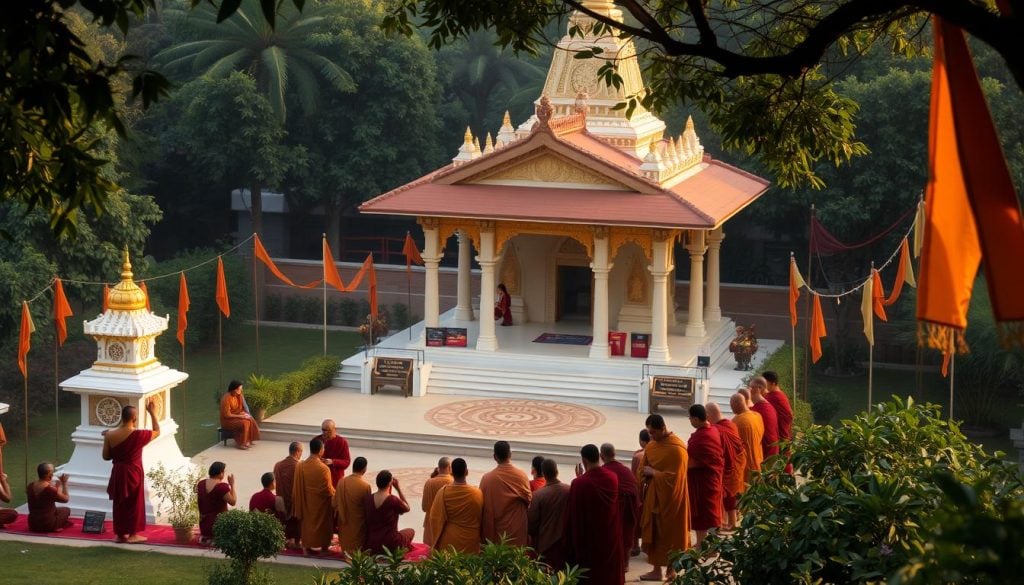
Witnessing the Maya Devi Temple Rituals
The Maya Devi Temple is a key sacred site for many. It brings people closer to their spiritual beliefs. Devotees make symbolic offerings, like throwing coins into ancient ruins, as a sign of devotion and to ask for blessings.
Exploring the temple, you’ll find a holy tree and a sacred pool. These add to the spiritual gatherings. The peaceful atmosphere makes it a special place for all who visit or join in the rituals.
“Each ritual offers a chance to connect with the divine, creating a profound experience that transcends the physical space.”
These rituals welcome people from all walks of life. They share a moment of spirituality and devotion. Seeing the Maya Devi Temple rituals is a chance to reflect and join in a tradition that has lasted for many generations.
The Procession for Buddha’s Birthday
The Buddha’s birthday celebration in Lumbini is a stunning event. It features colorful religious processions that show the strong spirituality and community bonds. Thousands come together, wearing bright clothes, carrying flowers, and praying deeply.
The air is filled with joy and devotion. People chant old mantras together, celebrating Buddhism’s core values.
Walking through Lumbini’s streets, you see floats with scenes from the child Buddha’s life. These floats remind us of the day’s cultural importance. They strengthen community ties and encourage thoughts on compassion and peace.
Monks lead the procession, their chanting beautiful and loud. It draws people to the temples, lifting their spirits.
Being part of this celebration lets you see tradition and joy together. It shows what it means to be in a community. People from everywhere come to honor the Buddha’s teachings.
In this special place, the celebration’s spirit is clear. It’s a moment filled with spirituality and community.
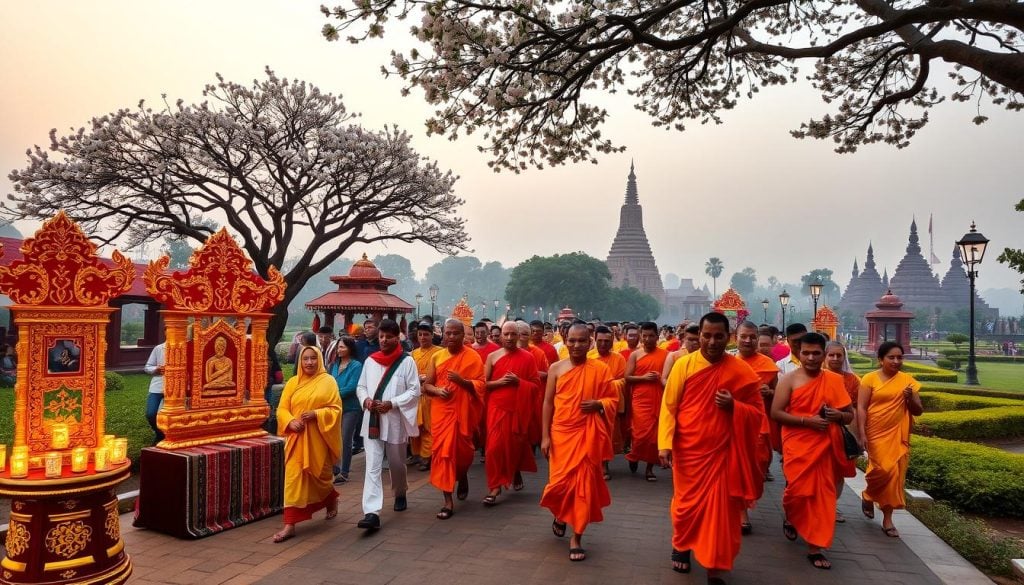
Traditional Buddhist Ceremonies Throughout the Year
Lumbini is a lively center for traditional Buddhist ceremonies all year. These events are very important, helping people deepen their faith. Each ceremony has its own rituals, following the lunar calendar. This lets believers fully participate in their spiritual journey in Lumbini.
Key ceremonies include:
- Vesak: Celebrates the Buddha’s birth, enlightenment, and death. Thousands gather for meditation and prayer.
- Asalha Puja: Marks the Buddha’s first teachings. It highlights the Dharma’s importance.
- Uposatha: A day for reflection and commitment renewal. Monks and laity join together.
- Naga Panchami: Honors serpent deities. It mixes local traditions with Buddhist practices.
These ceremonies build a sense of community. They show the diverse spiritual life in Lumbini. By taking part, people connect with their faith and live with compassion.
Each event reminds us of Buddhism’s history. People chant, make offerings, and come together. Sharing these moments strengthens bonds and faith.
| Ceremony | Date | Significance |
|---|---|---|
| Vesak | Full moon in May | Birth, enlightenment, and passing of the Buddha |
| Asalha Puja | Full moon in July | Buddha’s first teachings |
| Uposatha | Monthly, on the full moon | Renewal of precepts and reflection |
| Naga Panchami | Varies | Worship of serpent deities |
Spiritual Practices in Lumbini
In Lumbini, spiritual practices are key to enriching experiences for both pilgrims and visitors. You can dive into meditation in the Buddhist tradition, deepening your connection to Buddhism. These practices offer solitude, reflection, and community engagement in spiritual rituals, which are central to the local culture.
Meditation retreats in Lumbini provide peaceful settings for mindfulness and self-awareness. They use ancient techniques to help you find peace and understand Buddhist teachings better. Master teachers are there to support your growth, creating a nurturing environment.
Lumbini is a spiritual melting pot, thanks to its mix of local and international influences. You’ll find community chanting sessions that bring people together from all walks of life. This unity enhances your spiritual journey, showing how connection enriches spiritual practices in Lumbini.

































